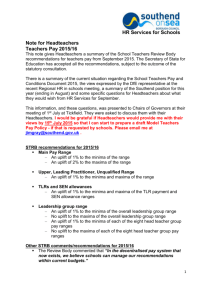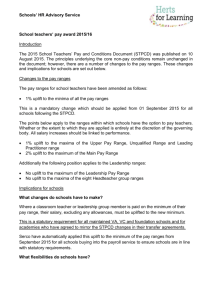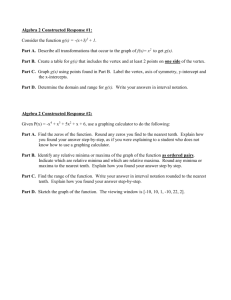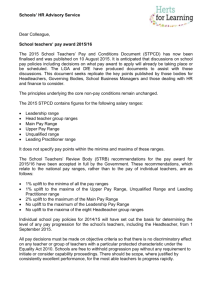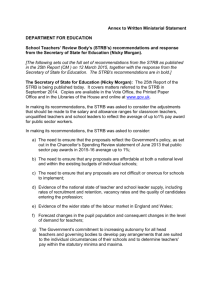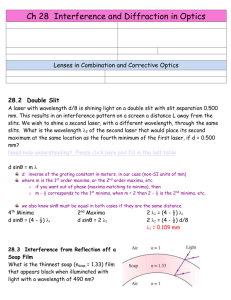Teachers Pay Award 2015 - HR Advice (July 2015)
advertisement
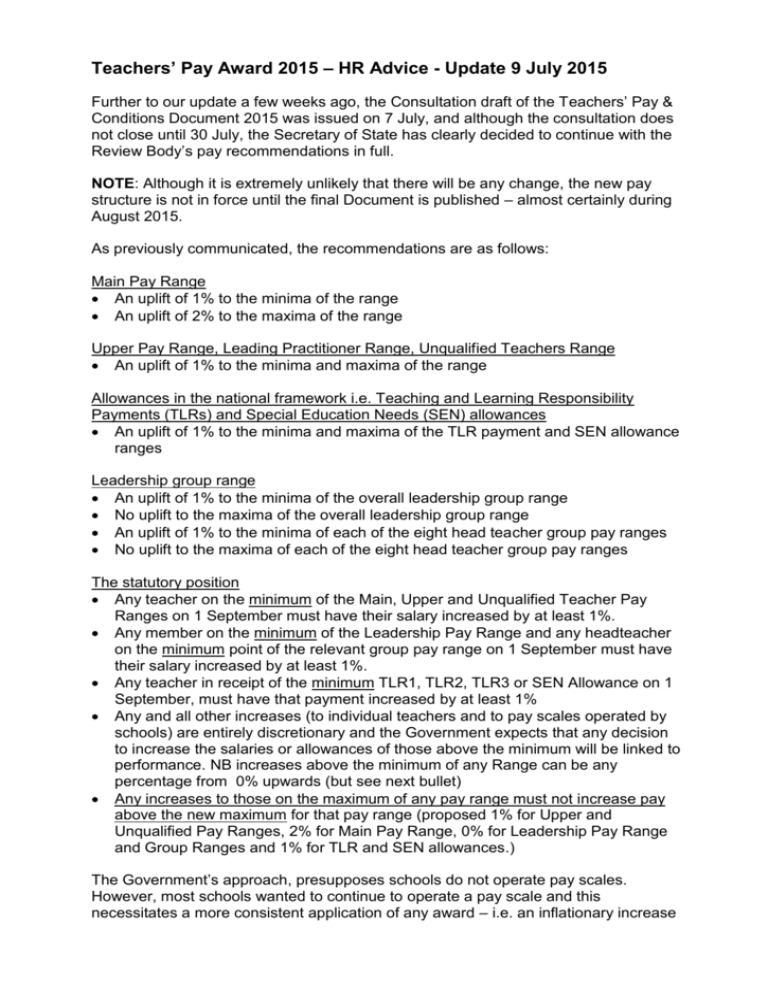
Teachers’ Pay Award 2015 – HR Advice - Update 9 July 2015 Further to our update a few weeks ago, the Consultation draft of the Teachers’ Pay & Conditions Document 2015 was issued on 7 July, and although the consultation does not close until 30 July, the Secretary of State has clearly decided to continue with the Review Body’s pay recommendations in full. NOTE: Although it is extremely unlikely that there will be any change, the new pay structure is not in force until the final Document is published – almost certainly during August 2015. As previously communicated, the recommendations are as follows: Main Pay Range An uplift of 1% to the minima of the range An uplift of 2% to the maxima of the range Upper Pay Range, Leading Practitioner Range, Unqualified Teachers Range An uplift of 1% to the minima and maxima of the range Allowances in the national framework i.e. Teaching and Learning Responsibility Payments (TLRs) and Special Education Needs (SEN) allowances An uplift of 1% to the minima and maxima of the TLR payment and SEN allowance ranges Leadership group range An uplift of 1% to the minima of the overall leadership group range No uplift to the maxima of the overall leadership group range An uplift of 1% to the minima of each of the eight head teacher group pay ranges No uplift to the maxima of each of the eight head teacher group pay ranges The statutory position Any teacher on the minimum of the Main, Upper and Unqualified Teacher Pay Ranges on 1 September must have their salary increased by at least 1%. Any member on the minimum of the Leadership Pay Range and any headteacher on the minimum point of the relevant group pay range on 1 September must have their salary increased by at least 1%. Any teacher in receipt of the minimum TLR1, TLR2, TLR3 or SEN Allowance on 1 September, must have that payment increased by at least 1% Any and all other increases (to individual teachers and to pay scales operated by schools) are entirely discretionary and the Government expects that any decision to increase the salaries or allowances of those above the minimum will be linked to performance. NB increases above the minimum of any Range can be any percentage from 0% upwards (but see next bullet) Any increases to those on the maximum of any pay range must not increase pay above the new maximum for that pay range (proposed 1% for Upper and Unqualified Pay Ranges, 2% for Main Pay Range, 0% for Leadership Pay Range and Group Ranges and 1% for TLR and SEN allowances.) The Government’s approach, presupposes schools do not operate pay scales. However, most schools wanted to continue to operate a pay scale and this necessitates a more consistent application of any award – i.e. an inflationary increase has to be applied to all scale points on those scales and to individual teachers on those scale points. To not do so would skew the scale, erode differentials between points and leave individual staff on the same point but on different values. The statutory position also has to be viewed in the context of individual Pay Policies and clearly the anomalous increase of 2% was not anticipated when Pay Polices were set last year and this increase may present some challenges. Application of the award You will be aware that given the considerable freedoms now available to schools and academies in relation to pay, we seek to provide guidance on the range of options available and in relation to the 2015 Pay Award, these are set out below. These must be considered in the context of your Pay Policy, the pay structure you have adopted (eg number of scale points) and the statutory position set out above. In additionally Academies are not bound by the terms of the Pay Award, subject to relevant provisions in their Pay Policy. 1. The simplest and least controversial option is to apply the 2% to the maximum point on the Main Pay scale, and apply it to all staff on that point, and to apply 1% to all other points and staff (other than maxima for leadership groups/range). 2. Some schools have expressed concerns about the affordability of the 2% increase on the Main Pay Range. In this context the following options may be considered. However, schools and academies are advised to give very careful consideration to the genuine financial difficulties (the difference between 1% and 2% is approximately £350 per teacher), as non-application of the 2% is likely to lead to conflict with staff and the trade unions (see below). 2a. Apply the 2% to the maximum point on the Main Pay scale and apply it all staff on that point. Apply 1% to maximum of all Upper and Unqualified scales and apply to all staff on those points. Apply 1% to all minima points and all staff on those points. Apply less than 1% to the points in-between, either on the main or all ranges, to offset the costs of the 2%. o This is permitted by existing pay policies which refer to “applying the pay award”, as the pay award applies only to the minima and maxima of the pay ranges. It will however distort the pay scales and is likely to be very unpopular with staff. 2b. If your Pay Policy currently indicates that you will apply inflationary increases across all scales and teachers, amend the Pay Policy (following staff consultation) before 1 September. However the timing of the publication of TPCD makes it extremely difficult to manage a meaningful consultation by September in which case the pay award will have to be applied in line with existing Policies as above. The suggested amendment would be to Inflationary increases (3.2): “The school will ensure that the values of the minimum point of each pay range in this Policy are in line with the minimum of the corresponding ranges set out in the Teachers’ Pay and Conditions Document. The values of points on the scales above the minimum will be determined annually by the Governing Body. In making its determination the Governing Body will have regard to any national pay award and any requirements set out in Teachers’ Pay and Conditions.” This amendment will allow schools to either: Apply 1% to all points and teachers on the Main Pay Range (and 1% to all other points and teachers as permitted). This option will leave schools with a Main Scale with a maximum below the national maximum. This may not be sustainable in the long term, particularly if other schools are offering the higher maximum. or ii. Apply 1% to the maximum point on their Main Pay scale, and apply that to individual teachers on that point but allow for 2% to be awarded to those that demonstrate exceptional performance. Schools will need to be very careful in being able to objectively and robustly demonstrate differential performance to avoid equal pay claims. Schools adopting this approach are advised to denote the salary associated with a 2% increase as progression stage/Point 6a (or similar) – to avoid ambiguity regarding what salary a teacher paid at progression stage/Point 6 is being paid. i. If you wish to amend your Pay Policy, we attach an example of a consultation paper which may assist you (with thanks to MB). You must adapt this to your own circumstances and bear in mind the opportunity to consult staff within the required timescale. Allowances The position regarding allowances is the same. The minima must be increased. Anything above this is discretionary and should be considered as for the pay scales. Pay Policy Our revised Draft is currently with Unions for consultation and will be published in its final version as soon as the final TPCD 2015 is published. We have amended the section on inflationary increases as indicated above (2b) to ensure schools have maximum flexibility in the future. The union position Schools should be aware that certainly some of the professional associations are strongly opposed to discretionary application of inflationary increases and will expect all employers to apply 1% to all teachers (except leaders on the top of the group ranges) and 2% to those on the top of the Main Scale. The NASUWT have issued advice to its members to insist upon a strict application of the national pay award. It has however, in our view, misrepresented the statutory position by implying that it is mandatory for schools to increase the maxima of their pay ranges to the levels set out in TPCD. However, this is not mandatory – only the minima must be increased – all other increases are discretionary, but must be considered in line with your pay policy. ASCL have issued more moderate advice and we expect further advice from other Unions in due course. Reference Pay Points Finally, the Government has indicated that they will not be publishing reference points for any of the scales. We have however provided these for your information (as helpfully published by ASCL). You will need to amend where you have adopted a different pay structure/number of points. Note: The Leadership range is complicated by the fact that the leadership group may not receive an increase if at the top point of their relevant group size, but as there is an overlap of points between group sizes, they may receive an increase on the same point where it is not the top of a group size. The Main Pay Range has two amounts at the top to reflect the issues discussed. Where 2% is being applied to the top of the Main Pay Range, use the Point 6a figure. Where 1% is being applied delete 6a and use the Point 6 figure. The Future We do not anticipate that the recent budget announcement that Public Sector Pay will be restricted to 1% will alter this year’s pay award, although this will not be certain until the consultation period ends and the final TPCD is published. Nor can we be certain that this will not lead to higher award in the future – after all a 1% restriction on public sector pay has been the Government’s position for the last few years and this has not been applied universally this year. Payroll Payroll will not apply any uplift to teacher’s pay on 1 September. Schools will need to advice Payroll of the relevant pay for individual staff in accordance with instructions issued by them in due course. Example Consultation Paper Context The School Teachers Review Body(STRB) (under direction from the Department for Education) has removed incremental pay rises based on length of service, and made all pay rises for teachers performance related. This is enforced by Ofsted, who check that teacher pay awards are performance based. In response to this, and following consultation, Governors introduced a pay policy that retained the principle of scale points within the pay range, allowing teachers to know what their pay is likely to be as they move through their careers. This also allows the school to: Apply performance related pay rationally, consistently and fairly, Plan its budget There was no intention to move away from the principle that the school would implement national inflationary pay awards, and in all cases since then the school has done so. The Financial Situation for Schools National pay awards have not been funded by Government for some time. Schools have had to pay them from existing “flat cash” or (some cases eg Sixth Form funding) sharply reducing budgets. At the same time, there has been a significant increase in the costs of employing teachers in the shape of an increase to employers’ National Insurance contributions, and employers’ contribution to the Teachers’ pension scheme (neither of which increases teachers’ take home pay, but effectively represents a cut to school budgets). This will not change in 2015-16 and is unlikely to change for at least the next two years. This places schools in a very difficult financial position. The School anticipated and has budgeted for a 1% inflationary increase in teachers’ pay from September 2015. Through careful financial planning and the high productivity levels of its teachers and support staff the school can afford to deliver this, and remain financially viable until the end of the 2017 – 2018 school year (this is as far ahead as it is possible to plan). The proposed/actual changes are The 2015-16 National Pay Award Main Pay Range An uplift of 1% to the minima of the range An uplift of 2% to the maxima of the range Upper Pay Range, Leading Practitioner Range, Unqualified Teachers Range An uplift of 1% to the minima and maxima of the range Allowances in the national framework i.e. Teaching and Learning Responsibility Payments (TLRs) and Special Education Needs (SEN) allowances An uplift of 1% to the minima and maxima of the TLR payment and SEN allowance ranges Leadership group range An uplift of 1% to the minima of the overall leadership group range No uplift to the maxima of the overall leadership group range An uplift of 1% to the minima of each of the eight head teacher group pay ranges No uplift to the maxima of each of the eight head teacher group pay ranges These recommendations assume that there are no scale points within pay ranges, as this is the preferred position of the Department for Education. The decision not to set a single national inflationary percentage increase, and to increase the maxima of the main range by more than the minima was not anticipated, and makes it extremely difficult for schools such as ours that have decided to retain pay scales and to mirror national inflationary pay awards. The decision to increase the minima but not the maxima of leadership scales has a similar effect. Our Proposal for Staff Consultation The Governing Body proposes that: All points on the school’s teacher pay scale, together with all allowances, are increased by 1% from September 2015 To allow this, the paragraph on Inflationary Increases in our Pay Policy be changed from: o The value of pay ranges, including any performance pay progression stages, will be increased annually in accordance with the inflationary percentage determined nationally. All teachers and support staff will receive any nationally agreed inflationary increase. To o The school will ensure that the values of the minimum point of each pay range in this Policy are in line with the minimum of the corresponding ranges set out in the Teachers’ Pay and Conditions Document. The values of points on the scales above the minimum will be determined annually by the Governing Body. In making its determination the Governing Body will have regard to any national pay award and any requirements set out in Teachers’ Pay and Conditions. The alternative to this amendment whilst maintaining the sustainability of our budget would be to increase the highest point on our Main Pay Range by 2%, the lowest by 1%, and the points between them by significantly less than 1% in order to offset the cost of the 2% rise at the top point. Although allowable within our existing policy, and in line with the 2015 STRB recommendation, this would distort our salary range, and penalise those who are not either at the top or the bottom point of it. Proposals for dealing with the STRB recommendations on leadership pay will need to be determined by the Governing Body as there is an obvious conflict of interest that makes it inappropriate for Senior Leaders in school to be advising the Governing Body on this, or to be party to this decision making process. The Governing Body will need to make a decision on teacher’s pay early in September to ensure that any inflationary increase appears in teachers’ September pay. Responses to the proposals set out above are invited from all staff and should be made via email to xxxxx by xxxxx 2015.
